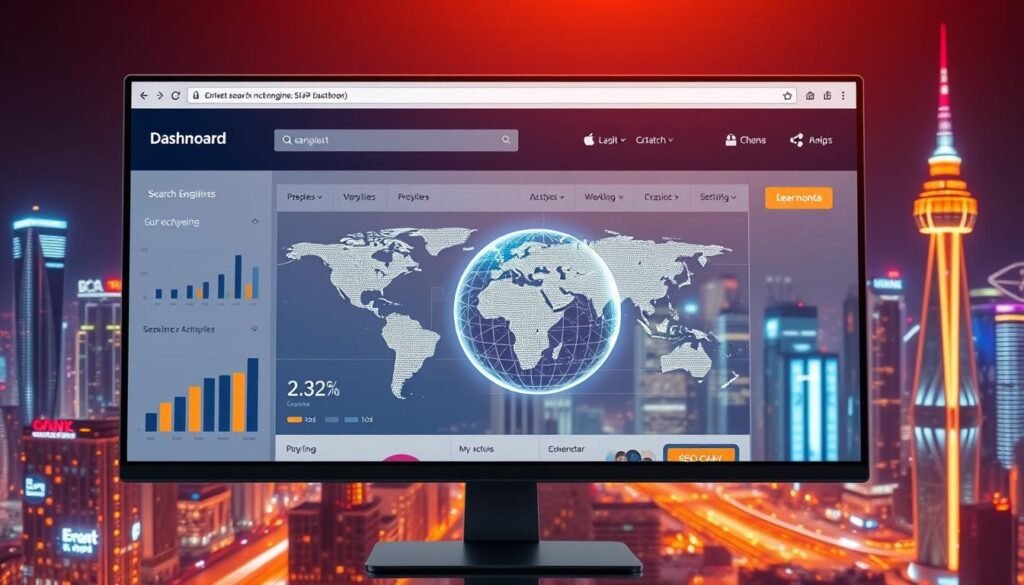97% of consumers look to the web first — and 56% won’t consider a business without a website. That gap is huge. It shows that visibility and credibility now decide who gets attention and who gets ignored.
Your website anchors the brand and centralizes information. Social media, listings, and reviews add third-party signals that build trust over time.
This section frames a practical list of options. Expect steps to futureproof your site, improve search results, scale content, focus social media efforts, and activate local listings for discovery.
We outline lifecycle tactics — email, paid media, and retargeting — so you can reach potential customers at each stage and shorten the time from awareness to action.
Aligning efforts to a clear audience makes each tactic amplify the others. The number and quality of touchpoints, not any single channel, determine lasting results.
Key Takeaways
- Most consumers begin their search online, so visibility is essential for every business.
- A modern website serves as the central hub for brand and trust.
- Combine site, listings, and social signals to improve credibility and search outcomes.
- Use lifecycle tactics—email to paid media—to guide potential customers to action.
- Prioritize high-impact, measurable steps and iterate with data to protect reputation.
Why a Strong Online Presence Will Matter Even More in the Future
Today’s shoppers piece together a view of a brand across sites, apps, and reviews. A strong online presence compounds discoverability and reputation because 83% of people visit a store after checking information first.
Multi-device, multi-platform behavior means consistent data and branding matter more than ever. Google and other search engines weigh cross-web signals when ranking results.
Build awareness through diversified touchpoints to meet people earlier and shorten the path to results. Brands that show up across website pages, marketplaces, reviews, and social channels become hard to ignore.
The reputation dividend is real: steady updates, quick responses, and clean data boost credibility and increase the chance a consumer chooses your business. Small firms can punch above their size when profiles match local intent.
- Durable foundations: clean data, quality content, trustworthy profiles.
- Proactive monitoring: track mentions, fix issues, iterate fast.
- Measure milestones: reach, engagement, and conversions to validate investment.
| Benefit | Why it matters | Short-term result | Long-term gain |
|---|---|---|---|
| Consistent data | Improves search engine signals | Faster discovery | Stronger reputation |
| Cross-channel content | Reinforces brand messaging | Higher awareness | More conversions over time |
| User reviews | Builds trust for shoppers | Increases foot traffic | Competitive advantage in industry |
Build a Trustworthy Website That Converts Visitors into Customers
A well-designed website turns casual visitors into confident buyers by reducing friction and answering key questions quickly.
Modern design signals credibility. Align typography, color, and imagery to reinforce brand quality and make actions obvious. Display security badges, clear returns, and warranty information to lower hesitation.
Mobile-first performance
Design for mobile first: most consumers shop on smartphones and search indexing is mobile-first. Keep pages light, forms thumb-friendly, and navigation simple to improve conversion rates.
Security, Core Web Vitals, and schema
Improve LCP, CLS, and INP with optimized images and minimal scripts to boost both user satisfaction and SEO results.
Use SSL, recognized payment providers, and visible trust signals when processing payments. Add schema (Organization, LocalBusiness, Product, FAQ) to enable rich snippets and better click-through rates.
- Clear architecture: surface contact, booking, and buy actions.
- Functional checks: make sure forms, search, and checkout work without friction.
- Social proof: testimonials, review badges, and certifications build trust fast.
| Focus area | Why it matters | Quick win |
|---|---|---|
| Design & UX | 75% of consumers judge credibility by design | Update hero, CTAs, and fonts |
| Mobile performance | 76% of Americans purchase via smartphone | Compress images, simplify forms |
| Security & Schema | Builds trust and improves SERP features | Enable SSL and add Product/FAQ schema |
Master SEO for Sustainable Search Engine Visibility
Sustainable search growth depends on two complementary pillars: on-site content and off-site technical signals. Treat them as equal investments: one builds relevance, the other builds trust and accessibility.
On-site content and keywords vs. off-site technicals and backlinks
On-site means high-quality content, targeted keywords, internal links, and optimized images. Map topics to buyer intent so pages answer both informational and transactional queries.
Off-site and technical work ensures your site is crawlable, fast, and uses schema for rich snippets. Authoritative backlinks and clean performance metrics improve how a search engine values your company over time.

Local SEO, Google Business, and the opportunity on Bing
Prioritize local pages, consistent NAP, and citations for service-area businesses. Don’t ignore Bing — it holds about 30% of US searches and can drive high-quality visitors with less competition.
- Measure rankings, organic traffic, and conversions to track progress.
- Earn links via expert content and digital PR to increase authority.
- Align stakeholders so SEO becomes a continuous business effort, not a one-time fix.
Use a Business Blog to Target More Keywords and Educate Your Audience
A business blog gives you room to target more niche queries and guide readers through buying decisions.
Plan content around the buyer journey: top-of-funnel (guides), mid-funnel (comparisons and case studies), and bottom-funnel (FAQs and tutorials). Each post should focus on one primary keyword or theme to keep signals clear for search engines.
Structure for visibility: use clear H2s for “People also ask,” bulleted or numbered lists for featured-snippet opportunities, and schema where relevant.
Promote new posts through social media and email to generate early engagement. Early clicks and shares help search rankings and drive customers into your funnel.
- Plan a content calendar that balances breadth and depth.
- Tie blog posts to product or services pages via internal links.
- Use analytics to measure which topics deliver results and iterate.
Cadence matters: companies that publish more frequently see bigger traffic and lead gains. Keep brand voice consistent and use real customer questions from sales or support to shape useful, trust-building content.
Social Media: Focus on Fewer Platforms, Deeper Engagement
A concentrated social approach beats scattershot posting when you want real engagement. Choose one to three platforms where your target audience spends time. Quality matters more than being everywhere.
Choose platforms your target audience actually uses
Map demographics and behavior before you commit. Facebook and Instagram still drive massive searches and discovery. Niche networks win for specific industries.
Social media SEO, hashtags, and community engagement
Use keywords in bios and captions, and prioritize niche or location hashtags to reach intent-aligned users. Ask questions, reply fast, and reward participation to grow followers and boost engagement.
- Align formats: short video, carousels, and stories should match each platform’s strengths.
- Connect channels: link profiles to your website and email capture to convert interest into owned traffic.
- Measure: track reach, saves, shares, and clicks to refine timing and creative.
Train teams on voice and moderation. Use social listening to spot conversations, inform content, and improve service. Over time, focused effort builds loyal followers and stronger brand results.
Claim Listings and Optimize Google Business for Local Discovery
Start with the major directories to ensure your info shows up where people search most.
Claim and verify core listings—Google Business Profile, Yelp, Facebook, Bing Places, and Foursquare—before expanding to niche directories.
Start with heavy hitters: Google, Yelp, Facebook, Bing, Foursquare
Yelp drives large traffic (about 178M monthly visits) and feeds Apple Maps and voice assistants. Bing handles roughly 30% of US searches, so Bing Places matters.
Make sure NAP is consistent and every field is fully populated
Populate every field: categories, hours, photos, services, menus, booking links, and Q&A. Add clear descriptions that explain why a customer should choose your company.
- Keep name, address, and phone identical across all listings to support rankings and avoid confusion.
- Add high-quality photos on your website and profiles to boost engagement and calls from listings.
- Encourage steady reviews and respond promptly to show active management and build trust.
- Link each listing back to the relevant website location page to reinforce authority and offer full information.
“Accurate listings turn search interest into visits, calls, and bookings.”
| Platform | Reach | Key benefit |
|---|---|---|
| Google Business Profile | High | Rich snippets and maps visibility |
| Yelp | Very high | Powers Apple Maps and voice assistants |
| Bing & Foursquare | Moderate | Alternative search traffic and app data |
Track views, actions, and calls, update seasonally, and refine listing content based on which platforms send your target audience the most meaningful traffic.
Email Marketing That Builds Relationships and Drives Results
A smart email strategy turns occasional visitors into repeat customers through timely, helpful messages.
Grow your list with targeted opt-ins: place simple forms on high-traffic pages, use slide-ins, and deploy exit-intent pop-ups to capture interest before a visitor leaves.
Grow your list with opt-ins, pop-ups, and lead magnets
Offer clear value—discounts, checklists, or exclusive guides—in exchange for an email address. Put opt-ins near content that already attracts readers, like the blog or product pages.
Segment, personalize, and comply with CAN-SPAM/GDPR
Segment by lifecycle (recent, repeat, lapsed) so messages stay relevant and engagement rises. Personalize subject lines and content to match user needs and reduce spam risk.
- Maintain deliverability: suppress inactive subscribers and remove stale addresses.
- Automate sequences: use welcome, nurture, and re-engagement flows to save time and drive measurable results.
- Measure and iterate: test send times, preview text, and CTAs to improve open and click rates without overwhelming the inbox.
“Newsletters remain one of the most consistent ways to drive repeat visits and conversions.”
Make sure you honor compliance: include clear unsubscribe options and follow CAN-SPAM and GDPR rules. Integrate email with your CRM and analytics to attribute conversions and refine strategy over time.
Amplify Reach with Paid Media and Smart Retargeting
Paid campaigns let you meet buyers where intent is already clear and speed up measurable results. Use search, social, and display options to reach the right audience at each stage of the funnel. Start small, test formats, then scale what works.
Search, social, and display ads to reach potential customers
Use search ads to capture high-intent queries and coordinate keywords with your organic pages. When paid and organic appear together, click likelihood increases.
Expand with social media ads for storytelling and demographic targeting across platforms. Display campaigns add cost-effective scale and frequency using contextual and in-market options.
Retargeting ads to re-engage site visitors at a lower CPC
Implement retargeting to re-engage visitors and cart abandoners. Typical retargeting CPCs run about $0.63–$1.23 versus average PPC CPC near $4.66, and 54% of marketers say retargeting delivers the top ROI.
Layer audiences—past buyers, email lookalikes, and high-value site segments—and tailor creatives to the products or services viewed.
- Make sure conversion tracking is active before launch to measure lift and allocate budgets.
- Pilot offers and creatives across platforms, then concentrate spend on top performers.
- Consider Bing and Google Local Services Ads for incremental reach and trust signals like “Google Guaranteed.”
- Use controlled budgets and iterative tests—headlines, imagery, and landing pages—to improve results over time.
“Start with small budgets, validate formats, and scale what proves efficient.”
Turn Reviews and Reputation Management into a Growth Engine
Customer feedback is one of the fastest ways to prove a business delivers on its promises. Treat reviews as marketing assets and operational signals, not just ratings on a page.

Proactively collect reviews on Google Business and key third-party sites. Embed direct review links in email and on your website to make it effortless for customers to respond right after purchase or service.
Respond fast, fix issues, and monitor mentions
Reply to every review quickly and professionally. Fast responses turn negative feedback into retention and show other consumers you care.
- Audit listings: correct inconsistent information that erodes trust and hurts search results.
- Analyze themes: use sentiment to find product gaps, training needs, and process fixes.
- Staff engagement: train teams to request reviews ethically at natural moments.
“Accurate listings and timely responses increase calls, directions, and conversions.”
Track metrics tied to reviews—calls, direction requests, and conversion—to quantify ROI. Close the loop by thanking reviewers and sharing how their input improved the business. That builds long-term relationships and stronger reputation.
Level Up with Video, Influencers, PR, and Niche Communities
Video and earned media amplify your marketing mix by showing real results, building trust, and driving traffic that converts.
Video that builds awareness and trust
Produce high-value video content—how-tos, testimonials, behind-the-scenes, and before/after clips—to meet viewers where they already watch. The average American spends about 48 minutes per day on YouTube, so prioritize formats that teach and demonstrate real outcomes.
Optimize titles, tags, captions, and descriptions. Publish consistently to improve discoverability and engagement across platforms.
Influencer collaborations aligned to your brand and audience
Partner with creators whose followers match your target market. Establish clear relationship rules, require disclosures, and use UTMs plus dedicated landing pages to measure ROI. Influencer efforts often return strong value—track results to scale the best partnerships.
Earn media with PR, and show expertise in forums and groups
Pitch newsworthy, data-backed angles to secure coverage and backlinks. Join niche forums and professional groups to answer questions, share examples, and build credibility over time. Consistent listings and accurate NAP remain important when you engage community channels.
- Integrate video: add clips to product pages, email, and social media to extend reach.
- Measure engagement: watch time, comments, and shares to refine formats.
- Use example-led content: show outcomes, not just claims, to strengthen trust and brand recall.
“Treat PR, influencers, and communities as reputation accelerators that amplify owned and paid channels.”
Conclusion
A repeatable system that links website quality, SEO, and customer signals delivers steady business momentum.
Build a strong online presence by treating your site, structured content, and technical SEO as the foundation for discoverability and trust. Add blogging, email marketing, and social media to nurture your audience and turn interest into measurable results.
Claim listings, manage reviews, and protect your reputation so local customers find accurate information at decision time. Use paid media, retargeting, and video to accelerate reach while organic effort compounds.
Next steps: prioritize fixes on the website, map a content calendar, validate paid tests, and track the right metrics. Align teams on brand standards and customer-focused content to make services and products clear and proven. Disciplined iteration—guided by analytics and real feedback—turns a coordinated effort into a durable competitive advantage for your company.
FAQ
What are the key strategies to elevate your online presence?
Focus on a trustworthy website, targeted SEO, a business blog, selective social media channels, optimized Google Business listings, email marketing, and strategic paid media. Combine high-quality content, clear calls to action, and consistent branding to reach potential customers and improve search results.
Why will a strong online presence matter more in the future?
Consumers increasingly research products and services on search engines and social platforms before buying. A robust digital footprint builds brand awareness, trust, and discoverability, helping businesses capture higher-intent traffic and convert visitors into customers as competition grows.
What makes a website convert visitors into customers?
Modern design that signals credibility, mobile-first performance, fast Core Web Vitals, strong security (HTTPS), and schema markup all work together. Clear messaging, intuitive navigation, and optimized product or service pages shorten the path to conversion.
How should I approach SEO for sustainable visibility?
Balance on-site content and keywords with off-site technical work and backlinks. Prioritize quality content, correct site structure, fast page speed, and authoritative links. Local SEO and claiming Google Business can drive nearby customer traffic while also leveraging Bing and other search engines.
How can a business blog help my marketing?
A blog targets more keywords and educates your audience across the buyer journey. Plan TOFU, MOFU, and BOFU content, use clear headings and lists to win featured snippets, and promote posts via social platforms and email campaigns to boost traffic and leads.
How do I choose the right social media platforms?
Pick the platforms where your target audience actually spends time. Focus on fewer channels and invest in deeper engagement, community building, and social media SEO through relevant hashtags, consistent posting, and authentic interactions.
Which listings should I claim to improve local discovery?
Start with the heavy hitters: Google Business Profile, Yelp, Facebook, Bing Places, and Foursquare. Ensure NAP (name, address, phone) consistency and fully populate every field to improve local search visibility and trust.
What are best practices for email marketing that drives results?
Grow your list with opt-ins, pop-ups, and lead magnets. Segment subscribers, personalize messages, and follow CAN-SPAM and GDPR rules. Use automated welcome series and targeted campaigns to nurture leads and boost repeat purchases.
When should I use paid media and retargeting?
Use search, social, and display ads to reach potential customers quickly and scale awareness. Deploy retargeting to re-engage site visitors with tailored offers at a lower CPC, improving conversion rates and ROI.
How can reviews and reputation management fuel growth?
Proactively collect Google and third-party reviews, respond promptly to feedback, fix issues, and monitor brand mentions. Positive reviews increase trust and search visibility, while timely responses protect reputation and customer relationships.
How do video, influencers, and PR fit into a growth strategy?
Use video for how-tos, testimonials, and behind-the-scenes content to build awareness and trust. Partner with influencers who match your brand and audience, and use PR and niche communities to earn media coverage and demonstrate expertise.



